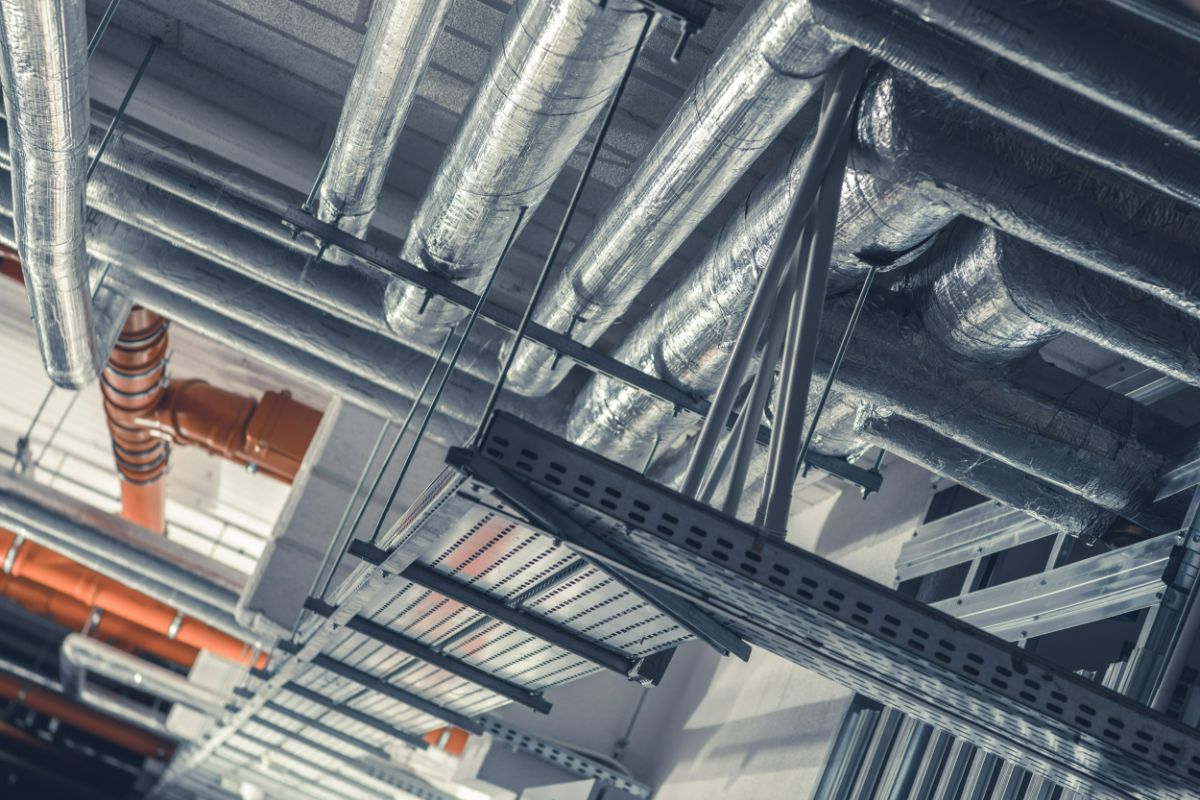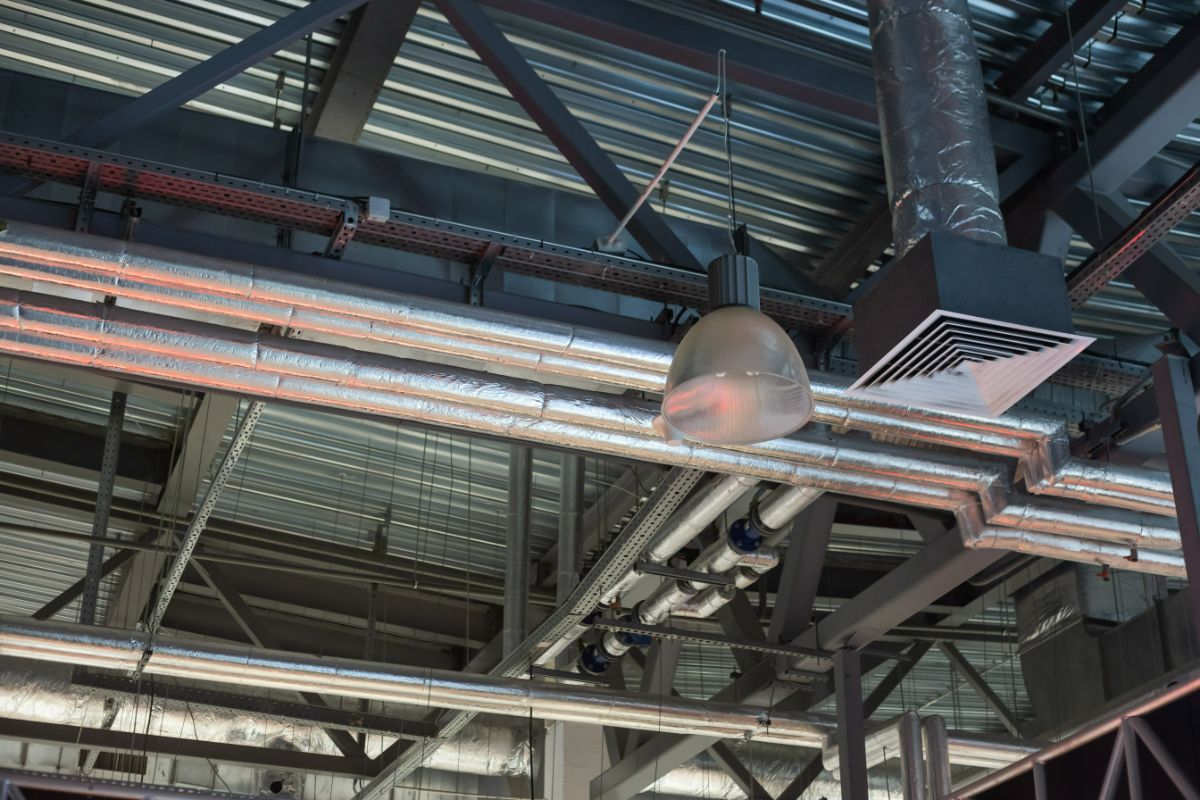Why is ductwork important?
- Distributes and Regulates Air
- Ensure Good Indoor Air Quality
- Improves Energy Efficiency
- Ensures Durability and Longevity
Overview
Ductwork is an intricate network of channels designed to distribute conditioned air evenly within a building. Its size, shape, and material are customized to match specific HVAC needs.
It is vital in large corporate settings, acting as pathways for conditioned air to maintain optimal indoor conditions.
Ductwork plays a crucial role for businesses, serving as a fundamental component of HVAC systems. It operates as a complex network responsible for distributing conditioned air across large commercial and industrial spaces.
Think of it as the building’s respiratory system, ensuring that every room receives the right temperature for comfort and a pleasant indoor environment.
In this article, we’ll explore what ductwork is and its importance in various facilities, helping you understand its essential role. Continue reading to learn more.
What is Ductwork?
Ductwork comprises a network of channels or passages strategically created for evenly dispersing air within a building. Its size, shape, and material composition are tailored to match the distinct HVAC needs of a given structure. This intricate system significantly contributes to maintaining optimal indoor air quality, temperature control, and overall comfort by effectively conveying air to various zones.
Importance of Ductwork
The relevance of ductwork within HVAC is of utmost importance in sprawling corporate settings. Functioning as the pathways for conditioned air, it intricately navigates these expansive environments, orchestrating the dispersion of optimal indoor conditions.
Distributes and Regulates Air

The ductwork is a fundamental mechanism for distributing and regulating air throughout the large spaces of a facility. The process begins with the HVAC system generating heated or cooled air, depending on the desired indoor temperature. This air is then propelled into the ductwork through the main air handling unit. The ducts, often composed of sheet metal, fiberglass, or other durable materials, extend across the company’s premises, reaching various rooms, offices, and zones.
Strategically positioned vents, grilles, and registers are integrated into the ductwork and placed in different parts of the building. These outlets are points of air dispersion, enabling the conditioned air to be released into the designated areas. The placement of these openings is carefully calculated to achieve an even distribution and regulation of air, preventing hot or cold spots and ensuring uniform temperature levels.
Ensure Good Indoor Air Quality
Ductwork systems are equipped with air filters that effectively capture and eliminate airborne contaminants, such as dust, allergens, pollutants, and even microorganisms. As the air circulates through the ducts, these filters actively remove particles that could otherwise degrade indoor air quality and potentially affect the health and well-being of employees.
The strategic design and layout of this system also combat air stagnation, a common challenge in corporate spaces. Properly distributed air prevents pockets of stagnant air where contaminants may accumulate. This dynamic air movement helps maintain consistent air quality throughout the company’s premises, benefiting every corner and workspace.
Improves Energy Efficiency

The proper design, installation, and maintenance of ductwork play a pivotal role in conserving energy and reducing operational costs. As mentioned, it functions as the conduit for conditioned air to reach different areas, preventing overworking of HVAC equipment in certain zones while providing airflow to others. This eliminates excessive cooling or heating, thus conserving energy.
Furthermore, it also enables the implementation of zoning systems, which divide the building into different areas, each with its own separate thermostat and airflow controls. This allows for customized temperature settings in different zones based on occupancy, time and day of work, or other factors. Therefore, unoccupied or lightly used zones can be conditioned less intensively, leading to significant energy savings.
Ensures Durability and Longevity of the HVAC System
Finally, the durability and extended lifespan of ductwork hold significant importance due to the scale and complexity of their HVAC systems. By ensuring that ductwork remains robust and functional over time, companies can provide consistent performance and comfort to their occupants. This approach also helps companies make the most efficient use of their resources and minimize unnecessary expenses related to frequent replacements or repairs.
Key Takeaway
What is ductwork? It’s a system of channels or pipes used to transport air throughout a building for heating, ventilation, and air conditioning purposes. It plays a vital role in distributing conditioned air from HVAC systems to various rooms, ensuring consistent airflow and temperature control.
F.R. Sevilla is a distinguished ductwork manufacturer in the Philippines. Our commitment to excellence is evident in our highly trained staff, capable of producing top-tier ductwork, support, and accessories. Adhering to both industry standards and client requirements, we craft these products with precision.
Renowned for our world-class standards, impeccable workmanship, and unparalleled professionalism, we are the premier option for ductwork fabrication in the Philippines. For any inquiries or more information, please feel free to get in touch with us here and experience our exceptional services firsthand.
RECENT POSTS

5 Types of Air Filtration Systems Used in Medical Facilities
What are the types of air filtration systems in medical facilities? High-efficiency Particulate Air (HEPA) filters Ultra
Read More

Efficient Cooling Solutions: HVAC Care Tips for Offices in the Philippines Buildings
What are key HVAC care tips for offices in the Philippines? Schedule regular maintenance Change air filters regularly Ch
Read More

Importance of Regular HVAC Maintenance for Commercial Spaces in the Philippines
What is the importance of regular HVAC maintenance for commercial spaces? Maintain optimal performance Comfort and indoo
Read More